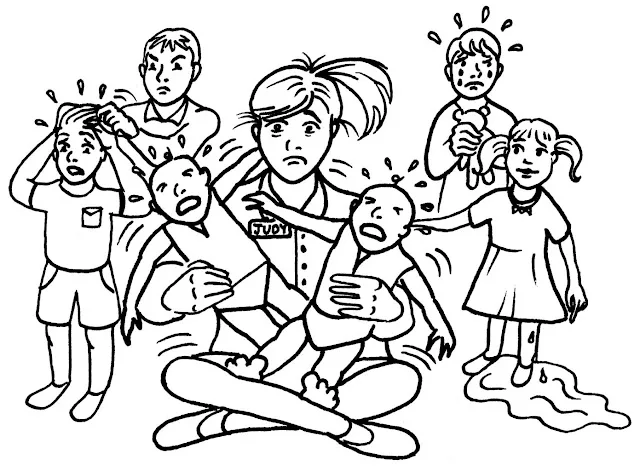Calming Strategies for a Distressed Baby
Introduction
It is a universal challenge for parents to calm their distressed baby. The process of discovering effective soothing strategies is crucial for both the baby’s well-being and the parent’s peace of mind. This article aims to provide an overview of the common causes of distress in babies and offer practical tips to help parents identify their baby’s unique cues and implement effective calming strategies.

Understanding the Reasons Behind Your Baby’s Distress
Common Causes of Distress in Babies
There are several reasons why a baby might be distressed, and it’s essential to understand these causes to address their needs effectively. Common causes include:
- Hunger: One of the most common reasons for a baby’s distress is hunger. Look for signs such as sucking on their hands, rooting, or becoming more alert.
- Tiredness: Babies can become overtired and have difficulty settling down. Watch for signs like yawning, rubbing their eyes, or becoming fussy.
- Discomfort: Discomfort from a wet diaper, gas, or other physical issues can cause distress. Check for signs of discomfort like squirming, arching their back, or grimacing.
- Overstimulation: Loud noises, bright lights, or too much activity can be overwhelming for a baby, leading to distress. Look for cues such as averting their gaze or becoming irritable.
- Need for comfort: Sometimes, a baby might be distressed because they need the comfort and security of their caregiver. They may seek cuddling, swaddling, or other forms of physical contact.
Identifying Your Baby’s Unique Cues
Each baby is unique, and understanding your baby’s specific signals and cues is crucial for effective soothing. Pay close attention to your baby’s body language, facial expressions, and sounds they make. Over time, you will become more adept at recognizing what your baby needs and responding accordingly. Keep in mind that what works for one baby may not work for another, so be prepared to experiment and adapt your approach as needed.
| Tips for Calming Your Baby | |
|---|---|
| 1. Swaddling | Wrap your baby snugly in a blanket to mimic the secure feeling of the womb. |
| 2. Holding and rocking | Gently hold, rock, or sway your baby to provide comfort and help them settle. |
| 3. Shushing | Make a “shush” noise close to your baby’s ear or use a white noise machine to mimic the womb’s sounds. |
| 4. Pacifiers | Offer a clean, age-appropriate pacifier for your baby to suck on for soothing. |
| 5. Skin-to-skin contact | Hold your baby against your bare chest to promote bonding and provide comfort. |
| 6. Calming environment | Create a soothing atmosphere with dim lights, soft music, and comfortable temperatures. |
| 7. Baby massage | Use gentle pressure and baby-safe oil to massage your baby and promote relaxation. |
| 8. Warm bath | Give your baby a comfortably warm bath to help them relax and soothe their distress. |
| 9. Establish a routine | Set consistent times for meals, naps, and bedtime to help your baby feel secure and understand when to sleep or eat. |
| 10. Be patient and flexible | Experiment with different strategies and remain open to adapting your approach as your baby’s needs change. |
Calming Strategies for a Distressed Baby
1. Swaddling
Swaddling mimics the snug feeling of the womb and can help a baby feel secure and calm. Make sure your baby is swaddled correctly and not too tightly, allowing room for their hips and legs to move.
2. Holding and rocking
Gently holding, rocking, or swaying your baby can provide comfort and help them settle. You can also try using a baby carrier or sling to keep them close while having your hands free.
3. Shushing
Mimicking the sound of the womb by “shushing” your baby can have a calming effect. Make a “shush” noise close to your baby’s ear or use a white noise machine or app.
4. Pacifiers
Some babies find sucking on a pacifier soothing. Ensure the pacifier is clean and age-appropriate for your baby.
5. Skin-to-skin contact
Skin-to-skin contact can be incredibly comforting for a baby, as it helps regulate their body temperature, heart rate, and breathing. Hold your baby against your bare chest, making sure their head is turned to the side to ensure a clear airway. This method is beneficial for both mom and dad to bond with the baby and provide comfort.
6. A calming environment
Creating a calm and soothing environment can help your baby feel more at ease. Dim the lights, reduce noise levels, and maintain a comfortable room temperature. Soft, calming music or lullabies can also be helpful.
7. Baby massage
Gently massaging your baby can help relieve tension and promote relaxation. Use baby-safe oil or lotion and apply gentle pressure while moving your hands in a circular motion. Be sure to avoid applying too much pressure, especially on their delicate joints.
8. Offer a warm bath
A warm bath can be soothing and relaxing for a distressed baby. Ensure the water temperature is comfortably warm, but not too hot. You can also add some baby-safe calming bath products to enhance the calming effect.
9. Establish a routine
Creating a consistent daily routine can help your baby feel more secure and make it easier for them to settle. Establish regular times for meals, naps, and bedtime to provide predictability and help your baby learn when it’s time to sleep or eat.
10. Be patient and flexible
Remember that calming a distressed baby can take time and persistence. Be patient, and don’t be afraid to try different strategies until you find what works best for your baby. As your baby grows and develops, their needs and preferences may change, so remain flexible and open to adapting your approach as needed.

Trial and Error: Finding What Works Best for Your Baby
When it comes to calming a distressed baby, it’s essential to recognize that every baby is unique and may respond differently to various soothing techniques. Patience and persistence are crucial in discovering the most effective calming strategies for your individual baby. It’s normal for some methods to work better than others, so be prepared to experiment with different approaches. Remember that as your baby grows and develops, their needs and preferences may change, and you may need to adapt your techniques accordingly.
When to Seek Professional Help
Recognizing Red Flags
While it’s common for babies to experience occasional distress, it’s essential to recognize signs that your baby’s distress may be due to a more serious underlying issue, such as illness or injury. Red flags to watch for include:
- High fever or a fever lasting more than a few days
- Difficulty breathing or changes in breathing patterns
- Persistent vomiting or diarrhea
- Unusual lethargy or irritability
- Signs of dehydration, such as sunken fontanelles (soft spots on the baby’s head) or decreased wet diapers
- Any signs of injury or trauma, such as bruises, swelling, or bleeding
Consulting a Pediatrician
If you notice any of the red flags mentioned above or have concerns about your baby’s well-being, it’s essential to consult a pediatrician or other healthcare professional for guidance and support. They can assess your baby’s condition, recommend appropriate interventions, and provide reassurance regarding your baby’s health. Additionally, they can offer advice on effective calming strategies tailored to your baby’s specific needs and circumstances. Remember that seeking professional help is not a sign of failure, but rather a proactive step towards ensuring the best care for your baby.
Conclusion
Calming a distressed baby can be a challenging yet essential task for parents. By understanding the common causes of distress, recognizing your baby’s unique cues, and implementing various calming strategies, you can help soothe your baby and promote their overall well-being. Remember that every baby is different, and what works for one may not work for another, so be patient and willing to experiment to find the best approach for your child.








